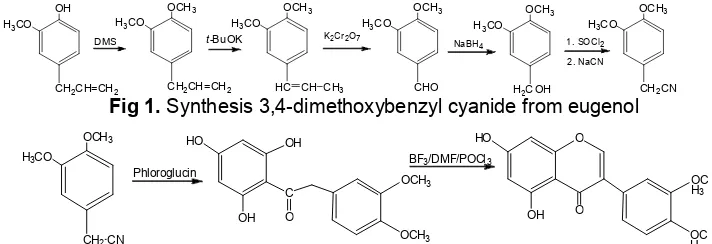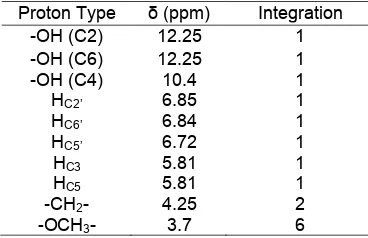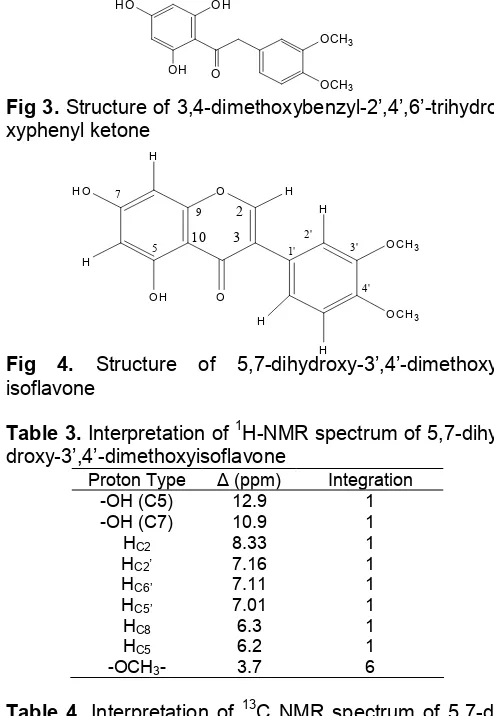SYNTHESIS OF 5,7-DIHYDROXY-3’,4’-DIMETHOXYISOFLAVON
FROM EUGENOL
Andi Hairil Alimuddin
1,2,*
,
Sabirin Matsjeh
3, Chairil Anwar
3, and Mustofa
41
Student of Doctorate Program, Department of Chemistry, Faculty of Mathematics and Natural Sciences, Universitas Gadjah Mada, Yogyakarta
2
Department of Chemistry, Faculty of Mathematics and Natural Sciences, Universitas Tanjungpura, Pontianak, Jl. Jenderal Ahmad Yani, Pontianak Kalimantan Barat
3
Department of Chemistry, Faculty of Mathematics and Natural Sciences, Universitas Gadjah Mada, Yogyakarta, Jl. Sekip Utara, Yogyakarta
4
Pharmacology Division, Faculty of Medicine Universitas Gadjah Mada, Yogyakarta, Jl. Farmaco Yogyakarta
Received May 30, 2011; Accepted September 24, 2011
ABSTRACT
Synthesis of 5,7-dihydroxy-3',4'-dimethoxyisoflavone from eugenol as isolated product of clove leaves oil had been done. Eugenol was firstly converted into 3,4-dimethoxybenzyl cyanide via several stages of reaction. Hoeben-Hoesch reaction of 3,4-dimethoxybenzyl cyanide with phloroglucin produced 3,4-dimethoxybenzyl-2’,4’,6’-trihydroxyphenyl ketone (deoxybenzoin intermediate) in 58% yield. Eventually, cyclization of the intermediate with reagents of BF3.OEt2/DMF/POCl3yielded 5,7-dihydroxy-3’,4’-isoflavone in 88% yield.
Keywords:eugenol, isoflavone, deoxybenzoin intermediate
INTRODUCTION
The diversities of structure and biological activities of isoflavones isolated from various natural products have been widely reported. Isoflavones showed significant biological activities which can inhibit the development of breast [1], cervical [2] and liver cancer cells [3].
The isoflavones isolated from natural products are obtained in very limited amount, so that efforts to synthesize isoflavones are really needed. In addition, the diversities of structure and biological activities of isoflavones make the synthesis of isoflavones is very important to develop new drugs with more interesting as well as potential therapy effects. Some anticancers of isoflavones had been synthesized such as genistein, daidzein, biochanin A and formononetin [4].
Several synthetic routes have been developed such as the synthesis of isoflavones via intermediates chalcone [5-6], cromone [7-8] and deoxybenzoin [9]. The synthetic route from deoxybenzoin (benzyl phenyl ketone) intermediate is mostly conducted. Preparation of deoxybenzoin that can be done through two methods: based on the Hoeben-Hoesch reaction between phenolic and benzyl cyanide compounds and The Friedel-Crafts acylation between phenolic compounds and phenyl acetic acid. Therefore, benzyl cyanide and benzyl carboxylate derivative are the key compound in the isoflavones synthesis through deoxybenzoin.
An effort to provide the key compound might be done by applying the abundance Indonesian natural product like eugenol. Eugenol is a major component of clove leaves oil (80%). Chemical property of eugenol, i.e. the presence of allylic group, gives possibility to convert eugenol into 3,4-dimethoxybenzyl cyanide.
This research was related to the synthesis of isoflavones from eugenol. At the previous researches, eugenol had been successfully converted into 3,4-dimethoxybenzil cyanide via several stages, which were methylation of eugenol, isomerization of methyleugenol, oxidation of methylisoeugenol, reduction of 3,4-dimethoxybenzaldehyde, halogenation of dimethoxybenzyl alcohol and nitrilisation of 3,4-dimethoxybenzyl chloride to give the compound. Additionally, its structure had been elucidated by IR, H-NMR and GC-MS spectrometers.
This publication was focused to synthesis of isoflavone from 3,4-dimethoxybenzil cyanide. Condensation between phloroglucine and 3,4-dimethoxybenzyl cyanide was based on Hoeben-Hoesch reaction to produce 3,4-dimethoxybenzyl-2’,4’,6’-trihydroxyphenyl ketone (deoxybenzoin derivative). Reaction of deoxybenzoin with BF3
-OEt2/DMF/POCl3 as reagent to add one carbon
H3CO
Fig 1.Synthesis 3,4-dimethoxybenzyl cyanide from eugenol
Fig 2.Synthesis 5,7-dihydroxy-3’,4’-dimethoxyisoflavone from 3,4-dimethoxybenzyl cyanide
EXPERIMENTAL SECTION
Materials
All chemicals with pro analysis grade were purchased from E. Merck and used as such without any purification. The reagents and solvents were phloroglucine, POCl3, N,N-dimethylformamide (DMF),
boron trifluoride-etherate (BF3-Et2O), zinc chloride
(ZnCl2), methanol, ethanol, chloroform, ethyl acetate,
petroleum ether, diethyl ether, acetone, hydrochloric acid (HCl), sodium sulfate (Na2SO4) anhydrous, thin layer
chromatography (TLC) plat of aluminium F254.
Instrumentation
The instrumentation used in this research were laboratory glassware, magnetic stirrer, hotplate, Buchi Evaporator R-124, vacuum pump, UV lamp, melting point apparatus (Electrothermal 9100), infra red spectrometer (FT-IR, Shimadzu FTIR Prestige 21), proton and carbon nuclear mass resonance (1H and13C
NMR JEOL JNM ECA 500 MHz) and gas
chromatography-mass spectrometer (GC-MS Shimadzu QP2010S).
Procedure
Synthesis of 3,4-dimethoxybenzyl-2’,4’,6’-trihydroxy phenyl ketone
Phloroglucine (1.0 g), 3,4-dimethoxyphenylacetoni trile (1.2 g) and solution of ZnCl2 (0.62 g) in ether
(15 mL) was placed in 100 mL three-necked flask equipped with magnetic stirrer and connector gas. The reaction mixture were cooled in an ice bath and saturated with a stream of HCl gas (HCl was produced by reacting NaCl and concentrated H2S04) for 8 h. The
reaction mixture was refrigerated for 12 h. The precipitate after the ether was decanted was washed further with ether. The precipitate thus obtained was refluxed with 5% aqueous HCl (20 mL) for 7 h and cooled in refrigeration for a night. The solid that
precipitated was washed with aquadest, then its melting point was identified, spectroscopy analysis with FT-IR, MS,1H-NMR and13C-NMR.
Synthesis of 5,7-dihydroxy-3’,4’-dimethoxyisoflavo ne
Into 100 mL round-bottomed flask, 0.28 g (0.97 mmole) of 3,4-dimethoxy benzyl-2’,4’,6’-trihydroxyphenyl ketone and 1 mL of BF3.Et2O were
added. After it had been cooled at 10 °C, as much as 0.75 mL of DMF was added. The reaction mixture was heated until 50 °C and 0.2 mL POCl3in 1.2 mL of DMF
was dropped into it. Next, the reaction was continued for 4 h at 80-100 °C. The cool mixture was poured into 12% of cool sodium acetate solution to give precipitate. The precipitate was recrystallized and analyzed its melting point. Structure elucidation of product was performed using FT-IR 1H-NMR and 13C-NMR spectrometers.
RESULT AND DISCUSSION
Synthesis of 3,4-dimethoxybenzyl-2’,4’,6’-trihydroxy phenyl ketone
3,4-Dimethoxybenzyl cyanide was a key compound in isoflavone synthesis via the intermediate of deoxybenzoin (benzyl phenyl ketone). Its preparation could be done from eugenol, i.e. the major component of clove leaves oil which is relatively abundant in Indonesia. The synthesis pathway of 3,4-dimethoxy benzyl cyanide from eugenol was outlined in Fig. 1.
3,4-Dimethoxybenzyl cyanide became the starting material for synthesis of 3,4-dimethoxybenzyl-2’,4’,6’-trihydroxyphenyl ketone. The deoxybenzoin derivative was synthesized via Hoeben-Hoesch reaction between 3,4-dimethoxybenzyl cyanide and phloroglucine in the presence of Lewis acid of ZnCl2 as a catalyst. The
Table 1. Interpretation of1H-NMR spectrum of Hoeben-Hoesch acylation product
Proton Type δ(ppm) Integration
-OH (C2) 12.25 1
Table 2.Interpretation of13C NMR spectrum of Hoeben-Hoesch acylation product
Carbon Type δ(ppm)
C=O 202.6
The Hoeben-Hoesch reaction was begun with the formation of chloronitrile compounds which was produced by reaction of 3,4-dimethoxybenzyl cyanide that had a cyano group with HCl [10]. The Chloronitrile formed a coordination bond with ZnCl2 catalyst.
Cloronitril-ZnCl2complex was reacted with phloroglucine
to produced ketiminium chloride. The hydrolysis of ketiminium chloride using hydrochloric acid solution produced 3,4-dimethoxybenzyl-2’,4’,6’-trihydroxyphenyl ketone.
Product was obtained as a solid with melting point of 195-199 °C in 58% yield. Product was analyzed by IR,
1
H-NMR, 13C-NMR and MS spectrometers. IR spectrum of 3,4-dimethoxybenzyl-2’,4’,6’-trihydroxyphenyl ketone showed differences in characteristic peaks that can be distinguished with the reactant of 3,4-dimethoxybenzyl cyanide. IR spectrum of product showed the disappearance of cyano group peak at the wave number of 2245 cm-1 accompanied by the appearance of the absorption band of carbonyl group at wave number region 1620 cm-1. The frequency of C=O was shifted due to resonance or mesomeric effects. Delocalization of electrons phi between the C=O and ring raised the
character double bonds from bond that connecting of C=O with ring. This influence resulted the decrease in the level of bond from C=O bond, as a consequence of weak bond. The decreasing in the force constants decreased vibration frequency range [11]. FT-IR spectrum interpretation result showed that the starting material of 3,4-dimethoxybenzyl cyanide has reacted with phloroglucine to form 3,4-dimethoxybenzyl-2’,4’,6’-trihydroxyphenyl ketone.
Deoxybenzoin had a characteristic 1H-NMR spectrum that can be easily identified to distinguished between product and reactant by determined location of methylene group protons (-CH2-). Protons of
methylene group from deoxybenzoin appeared at chemical shift (δ) of 4-5 ppm; while protons of methylene group from benzyl cyanide was located at chemical shift of 3.7 to 3.8 ppm. Absorption proton of methylene group from deoxybenzoin shifted to the left (down field) compared with the benzyl cyanide.
The properties of 1H NMR spectrum of resulted product are presented in Table 1. 1H-NMR analysis showed peak in chemical shift 4.25 ppm with integration two hydrogen atoms was a signal of methylene group from deoxybenzoin. Therefore, it can be concluded that the resulting product is a deoxybenzoin compound. Proton at chemical shift (δ), 12.25 ppm represented the proton peak of hydroxyl group attached to C2 and C6. The two hydroxyl groups located at symmetrical positions so that it appearance on the same peak with integration two H atoms Proton C3 and C5 in ring A showed a similar appearance due to the peak located at symmetrical positions with integration 2 H atom. The peak at chemical shift 3.7 ppm was signals from methoxy group, reinforced by the results of integration which was six hydrogen atoms.
Spectroscopy analysis using 13C-NMR provides information related to carbon skeleton of the product, thus, strengthens previous analyses. According to
13
C-NMR spectrum are presented in Table 2, there are absorption signals in carbonyl, aryl, methoxy carbons region. The structure of 3,4-dimetoksibenzil-2’,4’,6’-trihidroksifenil ketones showed four carbon in symmetric positions i.e. carbon C2 with C6 and C3 with C5, therefore, the carbon peak is estimated there are 14 that emerged from 16 carbon atom contained in product. Two symmetrical peaks would indicate the height of carbon peak twice from the other carbon peaks.
O
compare to other carbon. Signal at 55.3 ppm represents carbon from methoxy groups. Methylene carbon appeared atδ= 48.5 ppm.
Further analysis using MS gives ion molecular peak at m/z 304. The value shows the molar mass of 3,4-dimethoxybenzyl-2,4,6-trihydroxyphenyl ketone. Based on FT-IR, MS, 1H-NMR and 13C-NMR supports that the compounds synthesized product was 3,4-dimethoxybenzyl-2’,4’,6’-trihydroxyphenyl ketone with the structure in Fig. 3.
Synthesis of 5,7-dihydroxy-3’,4’-dimethoxyisoflavone
The next steps in the isoflavone synthesis from deoxybenzoin derivative are the addition of one carbon at the position of methylene (-CH2-) and cyclization to
yield the isoflavone. There are several reagents which can be employed to add one carbon, such as BF3Et2O/DMF/methane sulfonil chloride (MeSO2Cl) [9],
BF3Et2O/DMF/PCl5[12],BF3Et2O/DMF/POCl3[12],acetic
formic anhydride [13], ethyl formate/Na [14], N,N-dimethylformamide dimethyl acetal refluxed with DMF or in THF [4]. In this research, cyclization of 3,4-dimethoxy-2’,4’,6’-trihydroxyphenyl ketone was performed using POCl3and DMF in BF3-Et2O which also
act as the solvent. The product with m.p. of 250-252 °C was obtained in 88% yield. Product analysis was the conducted by means of MS, 1H-NMR and 13C-NMR spectrometers. The properties of 1H NMR and 13C NMR spectrum of resulted product presented in Table 3 and Table 4.
Proton NMR analysis showed that isoflavone compounds synthesized have been formed. This interpretation is based by the disappearance of absorption peak at 4.25 ppm which is a typical absorption of methylene protons between deoxybenzoin substance caused by the addition of one carbon atom using reagents BF3Et2O/DMF/POCl3. The addition of one
carbon atom followed by cyclization process characterized by loss of one proton peak of hydroxyl group is accompanied by the appearance of absorption at 8.3 ppm region showing the C2 proton absorption peak (Fig. 3) of isoflavones. Absorption peak indicates that the cyclization reaction occurs between the hydroxyl group attached to C2 of ring A deoxybenzoin with one methylene group results addition of one carbon atom using reagent BF3Et2O/DMF/POCl3.
Further analysis by13C NMR done to strengthen the indication that the compound produced was 5.7-dihydroxy-3'.4'-dimethoxyisoflavone. In 13C-NMR spectrum isoflavone products will show the addition of one atom of C as a result of the process of adding one atom at the methylene group C deoxybenzoin using reagents BF3Et2O/DMF/POCl3. The process of adding
one carbon atom at position methylene (-CH2-) causes
Fig 3.Structure of 3,4-dimethoxybenzyl-2’,4’,6’-trihydro xyphenyl ketone
Fig 4. Structure of 5,7-dihydroxy-3’,4’-dimethoxy isoflavone
Table 3.Interpretation of 1H-NMR spectrum of 5,7-dihy droxy-3’,4’-dimethoxyisoflavone
Proton Type Δ (ppm) Integration
-OH (C5) 12.9 1
Table 4. Interpretation of 13C NMR spectrum of 5,7-di hydroxy-3’,4’-dimethoxyisoflavone
Carbon Type δ(ppm)
C=O 180
Further analysis using MS gives ion molecular peak at m/z 314. The value shows the molar mass of 5,7-dihydroxy-3',4'-dimethoxyisoflavone. Based on 1H-NMR,
13
C-NMR and MS analysis, it can be concluded that the product compound was 5,7-dihydroxy-3',4'-dimethoxyisoflavone with structure as shown in Fig. 4.
CONCLUSION
Condensation between 3,4-dimethoxybenzyl cyanide, which was obtained from eugenol, and phloroglucine was based on Hoeben-Hoesch reaction and conducted to produce 3,4-dimethoxybenzyl-2’,4’,6’-trihydroxy-phenyl ketone (deoxybenzoin derivative) in 58% yield. The addition of one carbon atom followed with cyclization using BF3Et2O/DMF/POCl3 reagents
yielded 5,7-dihydroxy-3’,4’-dimethoxyisoflavone (85% yield).
ACKNOWLEDGEMENT
In this opportunity, We, the authors, would thank to State Minister for Research and Technology which gave fund to this research according to the decree of State Minister for Research and Technology, No. 194/M/Kp/X/2008. October 3rd, 2008.
REFERENCES
1. Heo, M.Y., Sohn, S.J., dan Au W.W., 2001, Mutat. Res.,488, 2, 135–150.
2. Choi, E.J. and Kim, G-H, 2008, Phytomedicine, 15, 9, 683–690.
3. Yeh, T.C., Chiang, P.C., Li, T.K., Hsu, J.L., Lin, C.J., Wang, S.W., Peng, C.Y., and Jih-Hwa, 2007, Biochem. Pharmacol., 73, 6, 782–792.
4. Chang, Y.C., Nair, M.G., Santell, R.C. and Helferich, W.G., 1994, J. Agric. Food Chem., 42, 1869–1871.
5. Antus, S., Farkas, L., Gottsegen, Á., Kardos-Balogh, Z., and Nógrádi, M., 2006, Chem. Ber., 109, 12, 3811–3816.
6. Horie, T., Sasagawa, M., Torii, F., Kawamura, Y. and Yamashita, K., 1996,Chem. Pharm. Bull., 44, 3, 486–491.
7. Barve, V., Ahmed, F., Adsule, S., Banerjee, S., Kulkarni, S., Katiyar, P., Anson, C.E., Powell, A.K., Padhye, S., and Sarkar, F.H., 2006, J. Med. Chem.,49, 13, 3800–3808.
8. Vasselin, D.A., Westwell, A.D., Matthews, C.S., Bradshaw, T.D., and Stevens, M.F.G., 2006, J. Med. Chem.,49, 13, 3973–3981.
9. Faria, T.J., Silva, L.G.F., Filho, J.D.S., Chiari, E., and Oliveira, A.B., 2005, J. Braz. Chem. Soc., 16, 6B, 1415–1419.
10. Soidinsalo, 2007, Synthesis of Isoflavone Conjugates, Dissertation Department of Chemistry, Faculty of Science, University of Helsinki, Finland. 11. Sastrohamidjojo, H., 2001, Spektroskopi, Liberty,
Yogyakarta.
12. Sreenivasan, B., Ward, D.L. and Nair, M.G., 2000, J. Chem. Soc., Perkin Trans. 1,567–569.
13. Liu, D.F., and Cheng, C.C., 1991, J. Heterocycl. Chem., 28, 1641−1642.


